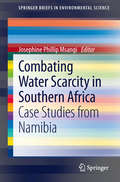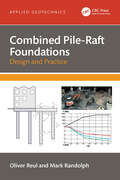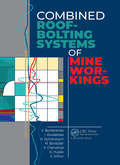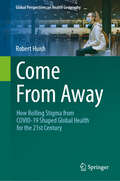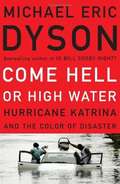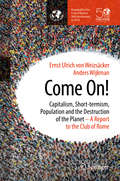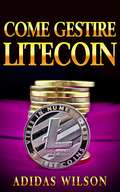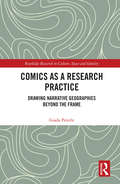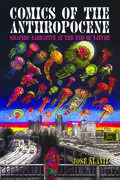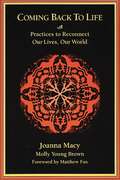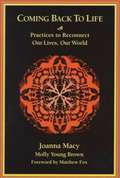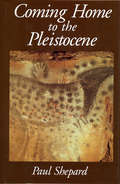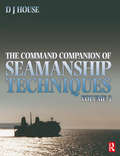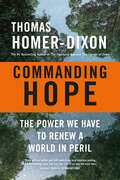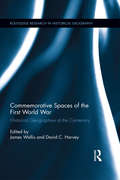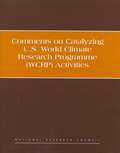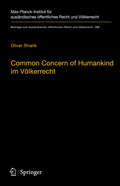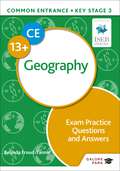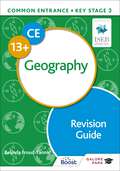- Table View
- List View
Combating Water Scarcity in Southern Africa: Case Studies from Namibia (SpringerBriefs in Environmental Science)
by Josephine Phillip MsangiThis book offers a close examination of water scarcity as a developmental challenge facing member nations of the Southern African Development Community (SADC), the interventions that have been implemented to combat the situation and the challenges still outstanding. The first chapter paints the backdrop of the water scarcity problem, reviewing historical approaches from the 1992 Earth Summit in Rio de Janeiro to the Johannesburg World Summit on Sustainable Development (2002) to the United Nations Rio+20 Conference on Sustainable Development (2012), and recapping principles and agreements reached during and after these conferences. Chapter two examines the Southern Africa region's efforts to combat water scarcity including principles, policies and strategies and the responsibility of each member to implement them. Written by the editor, J.P. Msangi, the chapter describes Namibia's efforts to ensure management of scarce water. Beyond enacting management and pollution control regulations and raising public awareness, Namibia encourages research to ensure attainment of the requirements of both the SADC Protocol and its own water scarcity management laws. The next three chapters offer Namibia-based case studies on impacts of pollution on water treatment; on the effects of anthropogenic activities on water quality and on the effects of water transfers from dams upstream of Von Bach dam. The final chapter provides detailed summaries of the issues discussed in the book, highlighting conclusions and offering recommendations. Combating Water Scarcity in Southern Africa synthesizes issues pertinent to the SADC countries as well as to other regions, and offers research that up to now has not been conducted in Namibia.
Combined Pile-Raft Foundations: Design and Practice (Applied Geotechnics)
by Mark Randolph Oliver ReulThis book presents the fundamental features of the design and performance of combined pile-raft foundations (CPRFs). Whereas in a traditional foundation the loads are carried either by the raft or by the piles, the capacity of CPRFs is assessed for the foundation as a whole, reducing total and differential settlements economically.The five chapters provide an overview of the historical development of piled rafts in practice and research, and of the design concepts developed for piled rafts over the last decades. Fundamental aspects of their bearing behaviour are presented, as well as an overview of the framework of the design process for CPRFs, including the safety concept, the design approach summarised in the ISSMGE Combined Pile-Raft Foundation Guideline (ISSMGE TC 212 2013) and the interaction between structural and geotechnical engineering. For numerical analysis based on the finite element method, guidance is given on creating the model and performing the calculations before providing basic information on the requirements for the site investigation, supervision of the construction process and monitoring of the foundation performance. Detailed case studies illustrate the design and performance of CPRFs, and a design example for the foundation of a multi-storey office building founded in non-cohesive soil is investigated, carrying out 3D finite element analysis to estimate deformations and design parameters for structural engineering.Based on the combined experience of the authors obtained in the last decades working in the industry and research, the book particularly suits consulting engineers engaged in foundation engineering, as well as graduate students and researchers interested in the bearing behaviour of piled rafts and pile groups.
Combined Roof-Bolting Systems of Mine Workings
by V. Bondarenko, I. Kovalevska, H. Symanovych, M. Barabash, V. Chervatiuk, O. Husiev and V. SnihurThe basic principles of geomechanical processes occurring in mine workings during the extraction of minerals are discussed in this monograph. Particular attention is paid to the support system, specifically to the various roof-bolt and frame support designs, and also to the modern means providing resource-saving conditions for ensuring mine workings sustainability. The basic principles of the computing experiment performance at the modelling of geomechanical processes are also presented and the stress-strain state of "rock massif – mine working support" systems are investigated. Finally, the results of field studies are discussed and illustrated. Modern studies are presented in this work, the advanced support systems are introduced and the solution to the problem of low-cost rock pressure control in mine workings is described. Further the unique study in the thin-layer massif of weak rocks is conducted and the technical and economic aspects of mine workings maintenance during rocks heaving are described. The book will be of interest to scientists in research and design organizations in the mining sector, engineers and technological workers in mines, as well as university academics and students.
Come From Away: How Rolling Stigma from COVID-19 Shaped Global Health for the 21st Century (Global Perspectives on Health Geography)
by Robert HuishThis volume takes a deep dive into the lasting legacy of stigma from the COVID-19 Pandemic. Self isolation, quarantine, face masks, hand washing, and travel restrictions are all ancient methods of pandemic management that extend past antiquity. Yet in a highly globalized pandemic, such ancient methods were the front lines of defense for a modern-day pandemic. And with such ancient methods come ancient problems, such as stigma. Based on two-years of extensive research in Nova Scotia, Canada, New Zealand, and Australia (jurisdictions that attempted to achieve Zero COVID) the book carefully outlines how with each wave of the pandemic a new group was blamed for it. When public measures were enforced, often anger was turned to groups who were assumed to have brought the virus into the country (or province). The nature of anger, and the nature of stigma evolved through the pandemic, but the impacts remain. In particular, the pandemic allowed jurisdictions to designate rights, and freedoms for people from certain places, while heavily penalizing others from away. The book argues that COVID-19 was born through globalization but the global response to it was fractured and divisive based on national and territorial identities as is reflected through targeted stigma. If another pandemic is to emerge, the book argues that a commitment to non-stigmatizing methods is needed in order to ensure compassion, dignity and respect, which are the ultimate goals of global health.
Come Hell or High Water: Hurricane Katrina and the Color of Disaster
by Michael Eric DysonCombining a fresh look at the key players in the disaster with his deep knowledge of black migrations and government policy over decades, Dyson provides the historical context that has been sorely missing from public conversation about Hurricane Katrina. He explores the legacy of black suffering in America since slavery and ties its psychic scars to today's crisis, even exploring the agonizing question that came from both survivors and right-wing apologists, "Did God cause Katrina?" His critique of the way black people are framed in the national consciousness will shock and surprise even the most politically savvy reader.
Come On!: Capitalism, Short-termism, Population and the Destruction of the Planet
by Anders Wijkman Ernst Ulrich von WeizsäckerCurrent worldwide trends are not sustainable. The Club of Rome’s warnings published in the book Limits to Growth are still valid. Remedies that are acceptable for the great majority tend to make things worse. We seem to be in a philosophical crisis. Pope Francis says it clearly: our common home is in deadly danger. Analyzing the philosophical crisis, the book comes to the conclusion that the world may need a “new enlightenment”; one that is not based solely on doctrine, but instead addresses a balance between humans and nature, as well as a balance between markets and the state, and the short versus long term. To do this we need to leave behind working in ”silos” in favor of a more systemic approach that will require us to rethink the organization of science and education.However, we have to act now; the world cannot wait until 7.6 billion people have struggled to reach a new enlightenment. This book is full of optimistic case studies and policy proposals that will lead us back to a trajectory of sustainability. But it is also necessary to address the taboo topic of population increase. Countries with a stable population fare immensely better than those with continued increase. Finally, we are presenting an optimistic book from the Club of Rome.
Come Rain or Shine: A Weather Miscellany
by Storm DunlopThis charming miscellany, as wide-ranging and unpredictable as the weather itself, is filled with curious historical facts, amazing statistics and fascinating anecdotes that will keep you entertained come rain or shine!
Come gestire Litecoin
by Adidas WilsonLitecoin è stato fondato per fungere da alternativa al Bitcoin, rimediando così alle limitazioni riscontrate da quest'ultimo - è stato sviluppato per essere "leggero" e più efficiente del Bitcoin. Inoltre ha un costo di pagamento quasi nullo e facilita i pagamenti circa quattro volte più velocemente del Bitcoin. Gli argomenti trattati includono: guida ai portafogli di criptovalute; come comprare Litecoin; minare Litecoin e altre altcoins; l'investimento migliore: Bitcoin o Litecoin; servizi di portafogli Litecoin; Bitcoin vs. Litecoin; e molto altro ancora.
Come into the Water: A Survivor's Story
by Merlyn MagnerRapid City, South Dakota, June 9,1972 . . . 238 people died, 5 are still missing. In the midst of one of the worst floods in the history of the United States, one young woman clung to the roof of a house, desperately holding on to the vestiges of her life. At the same time, the massive flood surging down from the Black Hills and through the city swept away everything and everybody she loved. Somehow, Merlyn Magner survived that horrific night, but she lost her brother, mother, and father to the rampaging water. Questions coursed through her mind then and for much of the rest of her life: Why did this happen? Why did my family die? Why did I survive? What does it all mean? Rescued from that rooftop, Merlyn set out to find the answers to these questions. She searched for comprehension, for a sense of place, for meaning Her search took her from the Black Hills on a journey around the United States and then the world, traversing the globe to escape the memories and the pain. From within this fractured fairy tale, she began a poignant, spiritual journey that would help her make sense of one horrendous night.
Comics as a Research Practice: Drawing Narrative Geographies Beyond the Frame (Routledge Research in Culture, Space and Identity)
by Giada PeterleThis book proposes a novel creative research practice in geography based on comics. It presents a transdisciplinary approach that uses a set of qualitative visual methods and extends from within the geohumanities across literary spatial studies, comics, urban studies, mobility studies, and beyond. Written by a geographer-cartoonist, the book focuses on ‘narrative geographies’ and embraces a geocritical and relational approach to examine comic book geographies in pursuit of a growing interest in creative, art-based experimental methods in the geohumanities. It explores comics-based research through interconnections between art and geography and through theoretical and methodological contributions from scholars working in the fields of the social sciences, humanities, literary geographies, mobilities, comics, literary studies, and urban studies, as well as from visual artists, comics authors, and art practitioners. Comics are valuable objects of geographical interest because of their spatial grammar. They are also a language particularly suited to geographical analysis, and the ‘geoGraphic novel’ offers a practice of research that has the power to assemble and disassemble new spatial meanings. The book thus explores how the ‘geoGraphic novel’ as a verbo-visual genre allows the study of geographical issues, composes geocentred stories, engages wider and non-specialist audiences, promotes geo-artistic collaboration, and works as a narrative intervention in urban contexts. Through a practice-based approach and the internal perspective of a geographer-cartoonist, the book provides examples of how geoGraphic fieldwork is conducted and offers analysis of the processes of ideation, composition, and dissemination of geoGraphic narratives.
Comics of the Anthropocene: Graphic Narrative at the End of Nature
by José AlanizSince the first Earth Day in 1970, how have US comics artists depicted the human-caused destruction of the natural world? How do these representations manifest in different genres of comics like superheroes, biography, underground comix, and journalism? What resources unique to the comics medium do they bring to their tasks? How do these works resonate with the ethical and environmental issues raised by global conversations about the anthropogenic sixth mass extinction and climate change? How have comics mourned the loss of nature over the last five decades? Are comics “ecological objects,” in philosopher Timothy Morton’s parlance? Weaving together insights from comics studies, environmental humanities, critical animal studies, and affect studies to answer these questions, Comics of the Anthropocene: Graphic Narrative at the End of Nature explores the representation of animals, pollution, mass extinctions, and climate change in the Anthropocene Era, our current geological age of human-induced environmental transformation around the globe. Artists and works examined in Comics of the Anthropocene include R. Crumb, Don McGregor et al.’s Black Panther, Jack Kirby’s Kamandi: The Last Boy on Earth, the comics of the Pacific Northwest, and Stephen Murphy and Michael Zulli’s landmark alternative series The Puma Blues. This book breaks new ground in confronting our most daunting modern crisis through a discussion of how graphic narrative has uniquely addressed the ecology issue.
Coming Back to Life
by Joanna R. Macy Molly Young BrownMany of us feel called to respond to the ecological destruction of our planet, yet we feel overwhelmed, immobilized, and unable to deal realistically with the threats to life on Earth. Noted spiritual and environmental thinkers Joanna Macy and Molly Young Brown contend that this crippling response to world crisis is a psychological defense mechanism that has been endemic since the years of the Cold War arms race, when we had to adapt within a single generation to the horrific possibility of nuclear holocaust.Since its publication in 1983, Joanna Macy's book, Despair and Personal Power in the Nuclear Age has sold nearly 30,000 copies and has been the primary resource for groups of men and women confronting the challenging realities of our time without succumbing to paralysis or panic. Coming Back to Life provides a much needed update and expansion of this pioneering work. At the interface between spiritual breakthrough and social action, Coming Back to Life is eloquent and compelling as well as being an inspiring and practical guide. The first third of the book discusses with extraordinary insight the angst of our era, and the pain, fear, guilt and inaction it has engendered; it then points forward to the way out of apathy, tio "the work that reconnects". The rest of the book offers both personal counsel and easy-to-use methods for working with groups in a number of ways to profoundly affect peoples' outlook and ability to act in the world.Table of ContentsForeword by Mathew Fox1. To Choose Life2. The Greatest Danger: Apatheia, The Deadening of Mind & Heart3. The Basic Miracle: Our True Nature & Power4. The Work that Reconnects5. Guiding Group Work6. Affirmation: Coming from Gratitude7. Despair Work: Owning & Honoring Our Pain for the World8. The Shift: Seeing with New Eyes9. Deep Time: Drawing on Past & Future Generations10. The Council of All Beings: Rejoining the Natural World11. Going Forth12. Meditations for Coming Back to LifeJoanna Macy has developed an international following over the course of 40 years as a speaker and workshop leader on Buddhist philosophy and the deep ecology movement
Coming Back to Life: Practices to Reconnect Our Lives, Our World
by Joanna R. Macy Molly Young BrownMany of us feel called to respond to the ecological destruction of our planet, yet we feel overwhelmed, immobilized, and unable to deal realistically with the threats to life on Earth. Noted spiritual and environmental thinkers Joanna Macy and Molly Young Brown contend that this crippling response to world crisis is a psychological defense mechanism that has been endemic since the years of the Cold War arms race, when we had to adapt within a single generation to the horrific possibility of nuclear holocaust. Since its publication in 1983, Joanna Macy's book, Despair and Personal Power in the Nuclear Age has sold nearly 30,000 copies and has been the primary resource for groups of men and women confronting the challenging realities of our time without succumbing to paralysis or panic. Coming Back to Life provides a much needed update and expansion of this pioneering work. At the interface between spiritual breakthrough and social action, Coming Back to Life is eloquent and compelling as well as being an inspiring and practical guide. The first third of the book discusses with extraordinary insight the angst of our era, and the pain, fear, guilt and inaction it has engendered; it then points forward to the way out of apathy, tio "the work that reconnects". The rest of the book offers both personal counsel and easy-to-use methods for working with groups in a number of ways to profoundly affect peoples' outlook and ability to act in the world.
Coming Back to Life: The Updated Guide to The Work that Reconnects
by Matthew Fox Molly Young Brown Joanna MacyDeepening global crises surround us. We are beset by climate change, fracking, tar sands extraction, GMOs, and mass extinctions of species, to say nothing of nuclear weapons proliferation and Fukushima, the worst nuclear disaster in history. Many of us fall prey to despair even as we feel called to respond to these threats to life on our planet.Authors Joanna Macy and Molly Brown address the anguish experienced by those who would confront the harsh realities of our time. In this fully updated edition of Coming Back to Life, they show how grief, anger, and fear are healthy responses to threats to life, and when honored can free us from paralysis or panic, through the revolutionary practice of the Work that Reconnects. New chapters address working within the corporate world, and engaging communities of color as well as youth in the Work.The Work that Reconnects has spread around the world, inspiring hundreds of thousands to work toward a life-sustaining human culture. Coming Back to Life introduces the Work's theoretical foundations, illuminating the angst of our era with extraordinary insight. Pointing the way forward out of apathy, it offers personal counsel as well as easy-to-use methods for group work that profoundly affect peoples' outlook and ability to act in the world.Joanna Macy is a scholar, eco-philosopher, teacher, activist, and author of twelve previous books including Coming Back to Life.Molly Young Brown is a teacher, trainer, counselor, and author of four previous books on psychology and Earth-based spirituality.
Coming Home to the Pleistocene
by Paul Shepard Florence R. ShepardPaul Shepard was one of the most profound and original thinkers of our time. Seminal works like The Tender Carnivore and the Sacred Game, Thinking Animals, and Nature and Madness introduced readers to new and provocative ideas about humanity and its relationship to the natural world. Throughout his long and distinguished career, Paul Shepard returned repeatedly to his guiding theme, the central tenet of his thought: that our essential human nature is a product of our genetic heritage, formed through thousands of years of evolution during the Pleistocene epoch, and that the current subversion of that Pleistocene heritage lies at the heart of today's ecological and social ills.Coming Home to the Pleistocene provides the fullest explanation of that theme. Completed just before his death in the summer of 1996, it represents the culmination of Paul Shepard's life work and constitutes the clearest, most accessible expression of his ideas. Coming Home to the Pleistocene pulls together the threads of his vision, considers new research and thinking that expands his own ideas, and integrates material within a new matrix of scientific thought that both enriches his original insights and allows them to be considered in a broader context of current intellectual controversies. In addition, the book explicitly addresses the fundamental question raised by Paul Shepard's work: What can we do to recreate a life more in tune with our genetic roots? In this book, Paul Shepard presents concrete suggestions for fostering the kinds of ecological settings and cultural practices that are optimal for human health and well-being.Coming Home to the Pleistocene is a valuable book for those familiar with the life and work of Paul Shepard, as well as for new readers seeking an accessible introduction to and overview of his thought.
Coming of Age at the End of Nature: A Generation Faces Living on a Changed Planet
by Julie Dunlap Susan A. CohenComing of Age at the End of Nature explores a new kind of environmental writing. This powerful anthology gathers the passionate voices of young writers who have grown up in an environmentally damaged and compromised world. Each contributor has come of age since Bill McKibben foretold the doom of humanity's ancient relationship with a pristine earth in his prescient 1988 warning of climate change, The End of Nature.What happens to individuals and societies when their most fundamental cultural, historical, and ecological bonds weaken-or snap? In Coming of Age at the End of Nature, insightful millennials express their anger and love, dreams and fears, and sources of resilience for living and thriving on our shifting planet.Twenty-two essays explore wide-ranging themes that are paramount to young generations but that resonate with everyone, including redefining materialism and environmental justice, assessing the risk and promise of technology, and celebrating place anywhere from a wild Atlantic island to the Arizona desert, to Baltimore and Bangkok. The contributors speak with authority on problems facing us all, whether railing against the errors of past generations, reveling in their own adaptability, or insisting on a collective responsibility to do better.
Command Companion of Seamanship Techniques
by David HouseThe Command Companion of Seamanship Techniques is the latest work from the well-respected marine author, D J House. It contains all the information needed for command posts at sea.· All aspects of shipboard management are discussed, with special emphasis placed on health and safety.· Guidelines on how to respond to accidents and emergencies at sea· Contains the most recent SOLAS revisions and a discussion of marine law to keep you up to date with the latest rules and regulations.In order to aid learning, the book includes a number of worked examples in the text along with questions and answers at the end of chapters. The author tells you how to respond to accidents and emergencies at sea, in the event, for example of cargo contamination, collision, loss of stability due to cargo shift and damage due to flooding, fire plus loss of life/crew. In addition, the SOLAS revisions and a discussion of marine law is included to keep you up to date with all the latest rules and regulations.In order to aid learning, this book will include a number of worked examples in the text along with questions and answers at the end of chapters.D J House is senior lecturer in Nautical studies at the Nautical college, Fleetwood. His sea-going experience includes general cargo, reefer, bulk cargo, passenger and liner trades, underwater operations, and roll-on/roll-off ferries. He is a well-known marine author and has written Seamanship Techniques Volumes 1 and 2 (combined) and he has revised Cargo Work in the Kemp & Young series.
Commanding Hope: The Power We Have to Renew a World in Peril
by Thomas Homer-DixonFrom the #1 BESTSELLING thought leader: Calling on history, cutting-edge research, complexity science and even Lord of the Rings, Thomas Homer-Dixon lays out the tools we can command to rescue a world on the brink.For three decades, the renowned author of The Upside of Down: Catastrophe, Creativity, and the Renewal of Civilization, and The Ingenuity Gap: Can We Solve the Problems of the Future?, has examined the threats to our future security--predicting a deteriorating global environment, extreme economic stresses, mass migrations, social instability and wide political violence if humankind continued on its current course. He was called The Doom Meister, but we now see how prescient he was. Today just about everything we've known and relied on (our natural environment, economy, societies, cultures and institutions) is changing dramatically--too often for the worse. Without radical new approaches, our planet will become unrecognizable as well as poorer, more violent, more authoritarian.In his fascinating long-awaited new book (dedicated to his young children), he calls on his extraordinary knowledge of complexity science, of how societies work and can evolve, and of our capacity to handle threats, to show that we can shift human civilization onto a decisively new path if we mobilize our minds, spirits, imaginations and collective values. Commanding Hope marshals a fascinating, accessible argument for reinvigorating our cognitive strengths and belief systems to affect urgent systemic change, strengthen our economies and cultures, and renew our hope in a positive future for everyone on Earth.
Commemorative Spaces of the First World War: Historical Geographies at the Centenary (Routledge Research in Historical Geography)
by James Wallis David C. HarveyThis is the first book to bring together an interdisciplinary, theoretically engaged and global perspective on the First World War through the lens of historical and cultural geography. Reflecting the centennial interest in the conflict, the collection explores the relationships between warfare and space, and pays particular attention to how commemoration is connected to spatial elements of national identity, and processes of heritage and belonging. Venturing beyond military history and memory studies, contributors explore conceptual contributions of geography to analyse the First World War, as well as reflecting upon the imperative for an academic discussion on the War’s centenary. This book explores the War’s impact in more unexpected theatres, blurring the boundary between home and fighting fronts, investigating the experiences of the war amongst civilians and often overlooked combatants. It also critically examines the politics of hindsight in the post-war period, and offers an historical geographical account of how the First World War has been memorialised within ‘official’ spaces, in addition to those overlooked and often undervalued ‘alternative spaces’ of commemoration. This innovative and timely text will be key reading for students and scholars of the First World War, and more broadly in historical and cultural geography, social and cultural history, European history, Heritage Studies, military history and memory studies.
Comments on Catalyzing U.S. World Climate Research Programme (WCRP) Activities
by Climate Research CommitteeThe National Academies Press (NAP)--publisher for the National Academies--publishes more than 200 books a year offering the most authoritative views, definitive information, and groundbreaking recommendations on a wide range of topics in science, engineering, and health. Our books are unique in that they are authored by the nation's leading experts in every scientific field.
Common Concern of Humankind im Völkerrecht (Beiträge zum ausländischen öffentlichen Recht und Völkerrecht #289)
by Oliver StrankDieses Buch untersucht die philosophischen Grundlagen und die geschichtliche Entwicklung des common concern of humankind-Begriffs und seine Rechtswirkungen im Völkerrecht. Hierbei wird das Prinzip in den Bestand des Umweltvölkerrechts eingeordnet und sein Verhältnis zum Grundsatz der Staatensouveränität untersucht. Außerdem wird das common concern-Prinzip vom common heritage-Prinzip abgegrenzt und völkerrechtstheoretisch dargelegt, welche Wirkung es als Prinzip innerhalb und außerhalb der von ihm erfassten Regime entfaltet. Der Autor begründet, dass mit der Verankerung des common concern of humankind-Prinzips in der Klimarahmenkonvention und im Pariser Abkommen sowie in der Biodiversitätskonvention die dort enthaltenen Umweltschutzpflichten zu solchen gegenüber der Staatengemeinschaft als Ganzes geworden sind, sodass sich alle Vertragsstaaten - unabhängig von einer eigenen Betroffenheit - gegenüber allen anderen Vertragsstaaten auf ihre Erfüllung berufen können und eine Klagebefugnis vor dem Internationalen Gerichtshof haben.
Common Entrance 13+ Geography Exam Practice Questions and Answers
by Belinda Froud-YannicExam board: ISEB Level: 13+ CE and KS3 Subject: Geography First exam: November 2022Help pupils feel fully prepared for their CE 13+ Geography exams with this extensive ISEB-endorsed exam practice book, aligned to the latest ISEB specification.· Boost confidence with ISEB exam-style questions: practise with a wealth of questions arranged by topic covering all areas of the specification.· Hone exam technique: familiarise pupils with the format and style of questions in the new exam.· Easily mark practice questions: answer guidance has been designed to be clear and easy-to-follow for teachers, parents or tutors marking practice questions, in line with the ISEB mark scheme.· Improve exam results: includes model answers with advice and guidance for achieving top marks.Cover all the topics and skills required for the exam with the Common Entrance 13+ Geography Revision Guide (ISBN: 9781398349674).
Common Entrance 13+ Geography Exam Practice Questions and Answers
by Belinda Froud-YannicExam board: ISEB Level: 13+ CE and KS3 Subject: Geography First exam: November 2022Help pupils feel fully prepared for their CE 13+ Geography exams with this extensive ISEB-endorsed exam practice book, aligned to the latest ISEB specification.· Boost confidence with ISEB exam-style questions: practise with a wealth of questions arranged by topic covering all areas of the specification.· Hone exam technique: familiarise pupils with the format and style of questions in the new exam.· Easily mark practice questions: answer guidance has been designed to be clear and easy-to-follow for teachers, parents or tutors marking practice questions, in line with the ISEB mark scheme.· Improve exam results: includes model answers with advice and guidance for achieving top marks.Cover all the topics and skills required for the exam with the Common Entrance 13+ Geography Revision Guide (ISBN: 9781398349674).
Common Entrance 13+ Geography Revision Guide
by Belinda Froud-YannicExam board: ISEB Level: 13+ CE and KS3 Subject: Geography First exam: November 2022Equip your pupils with the skills and confidence they need to excel in their 13+ CE Geography exams with this comprehensive ISEB-endorsed revision guide.· Revise all topics in the new specification: the guide covers all topics in the new ISEB specification in depth, including a new focus on the environment.· Clear illustrations with engaging visuals: well-annotated illustrations, photos, maps and charts aid learning and recall.· Build confidence ahead of the exam: hone technique with practice of ISEB exam-style questions, with tips and advice along the way.Practise with even more exam-style questions with Common Entrance 13+ Geography Exam Practice Questions and Answers (ISBN: 9781398322103).
Common Entrance 13+ Geography Revision Guide
by Belinda Froud-YannicExam board: ISEB Level: 13+ CE and KS3 Subject: Geography First exam: November 2022Equip your pupils with the skills and confidence they need to excel in their 13+ CE Geography exams with this comprehensive ISEB-endorsed revision guide.· Revise all topics in the new specification: the guide covers all topics in the new ISEB specification in depth, including a new focus on the environment.· Clear illustrations with engaging visuals: well-annotated illustrations, photos, maps and charts aid learning and recall.· Build confidence ahead of the exam: hone technique with practice of ISEB exam-style questions, with tips and advice along the way.Practise with even more exam-style questions with Common Entrance 13+ Geography Exam Practice Questions and Answers (ISBN: 9781398322103).
